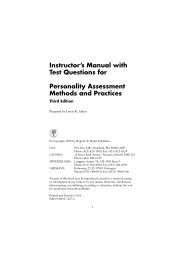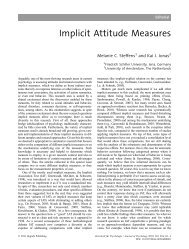download - Hogrefe Publishing
download - Hogrefe Publishing
download - Hogrefe Publishing
- No tags were found...
You also want an ePaper? Increase the reach of your titles
YUMPU automatically turns print PDFs into web optimized ePapers that Google loves.
James R. Rogers · David LesterUnderstandingSuicideWhyWe Don’tandHow We Might
Understanding Suicide: Why We Don’t and How We Might
Understanding Suicide:Why We Don’t and HowWe MightJames R. Rogers and David Lester
Library of Congress Cataloguing-in-Publication Datais available via the Library of CongressMarc Databaseunder the LC Control Number 2009933128Archives Canada Cataloguing in PublicationRogers, James R.Understanding suicide : why we don’t and howwe might / James R. Rogers and David Lester.Includes bibliographical references.ISBN 978-0-88937-359-41. Suicide. 2. Suicide--Psychological aspects.I. Lester, David, 1942-RC569.R64 2009 362.28 C2009-904607-5Copyright © 2010 by <strong>Hogrefe</strong> <strong>Publishing</strong>PUBLISHING OFFICESUSA: <strong>Hogrefe</strong> <strong>Publishing</strong>, 875 Massachusetts Avenue, 7th Floor, Cambridge, MA 02139Phone (866) 823-4726, Fax (617) 354-6875, E-mail info@hogrefe.comEUROPE: <strong>Hogrefe</strong> <strong>Publishing</strong>, Rohnsweg 25, 37085 Göttingen, GermanyPhone +49 551 49609-0, Fax +49 551 49609-88, E-mail publishing@hogrefe.comSALES & DISTRIBUTIONUSA:<strong>Hogrefe</strong> <strong>Publishing</strong>, Customer Services Department,30 Amberwood Parkway, Ashland, OH 44805Phone (800) 228-3749, Fax (419) 281-6883, E-mail custserv@hogrefe.comEUROPE: <strong>Hogrefe</strong> <strong>Publishing</strong>, Rohnsweg 25, 37085 Göttingen, GermanyPhone +49 551 49609-0, Fax +49 551 49609-88, E-mail publishing@hogrefe.comOTHER OFFICESCANADA: <strong>Hogrefe</strong> <strong>Publishing</strong>, 1543 Bayview Avenue, Toronto, Ontario M4G 3B5SWITZERLAND: <strong>Hogrefe</strong> <strong>Publishing</strong>, Länggass-Strasse 76, CH-3000 Bern 99<strong>Hogrefe</strong> <strong>Publishing</strong>Incorporated and registered in the Commonwealth of Massachusetts, USA, and in Göttingen, LowerSaxony, GermanyNo part of this book may be reproduced, stored in a retrieval system, or transmitted, in any form or byany means, electronic, mechanical, photocopying, microfilming, recording or otherwise, without writtenpermission from the publisher.Printed and bound in the USAISBN 978-0-88937-359-4
Table of ContentsIntroduction . . . . . . . . . . . . . . . . . . . . . . . . . . . . . . . . . . . . . . . . . . . . . . . . . . . . . . . . . 11. Introduction . . . . . . . . . . . . . . . . . . . . . . . . . . . . . . . . . . . . . . . . . . . . . . . . . . . . . . 32. General Methodological Issues . . . . . . . . . . . . . . . . . . . . . . . . . . . . . . . . . . . . . . . 7Part 1: The Disciplines . . . . . . . . . . . . . . . . . . . . . . . . . . . . . . . . . . . . . . . . . . . . . . . 273. Psychological Research into Suicide . . . . . . . . . . . . . . . . . . . . . . . . . . . . . . . . . . 294. Psychiatric Research . . . . . . . . . . . . . . . . . . . . . . . . . . . . . . . . . . . . . . . . . . . . . . 455. The Sociological Study of Suicide . . . . . . . . . . . . . . . . . . . . . . . . . . . . . . . . . . . 656. Anthropology and Suicide . . . . . . . . . . . . . . . . . . . . . . . . . . . . . . . . . . . . . . . . . . 83Part 2: Illustrative Topics . . . . . . . . . . . . . . . . . . . . . . . . . . . . . . . . . . . . . . . . . . . . . 977. Studies of Attitudes Toward Suicide . . . . . . . . . . . . . . . . . . . . . . . . . . . . . . . . . . 998. Studies of Sexual Abuse and Suicidality . . . . . . . . . . . . . . . . . . . . . . . . . . . . . . 1079. Assessing Suicidal Risk . . . . . . . . . . . . . . . . . . . . . . . . . . . . . . . . . . . . . . . . . . . 11910. Fads in Research: Sex Differences in Suicidal Behavior . . . . . . . . . . . . . . . . . 13511. Studies of Social Relationships . . . . . . . . . . . . . . . . . . . . . . . . . . . . . . . . . . . . . 14712. Suicide Notes and Other Personal Narratives . . . . . . . . . . . . . . . . . . . . . . . . . . 15713. Studies of the Suicidal Personality . . . . . . . . . . . . . . . . . . . . . . . . . . . . . . . . . . 16314. Typologies . . . . . . . . . . . . . . . . . . . . . . . . . . . . . . . . . . . . . . . . . . . . . . . . . . . . . 171Conclusions . . . . . . . . . . . . . . . . . . . . . . . . . . . . . . . . . . . . . . . . . . . . . . . . . . . . . . . 18115. Conclusions . . . . . . . . . . . . . . . . . . . . . . . . . . . . . . . . . . . . . . . . . . . . . . . . . . . . 183Appendix . . . . . . . . . . . . . . . . . . . . . . . . . . . . . . . . . . . . . . . . . . . . . . . . . . . . . . . . . 187Appendix . . . . . . . . . . . . . . . . . . . . . . . . . . . . . . . . . . . . . . . . . . . . . . . . . . . . . . . . . . 189
Introduction
1IntroductionSeveral years ago, Lester (2000) suggested that suicidology had come to an end. The thesisof that article was that very little of consequence had appeared in the last ten years that furtheredour knowledge of suicide – no new theory and no ground-breaking research.The end of the 20 th Century produced an interesting trend in the scholarly world – asense that everything was coming to an end. Francis Fukuyama (1992) declared thathistory had come to an end and that little of importance would happen in the future.David Lindley (1994) followed with a declaration that physics had discovered all thatthere was to be discovered, and John Horgan (1997a) declared that science in generalhad solved all of the puzzles. It seems clear that Fukuyama was wrong in asserting thatnothing of importance would occur in world history in the future – the rise in globalterrorism or climate change cannot be described as “of little importance” – but let uslook at Horgan’s views in more detail.Horgan (1997a) argued that pure science had entered its twilight, that is, there areno more profound revelations that will occur. He noted that science as a whole was notending but that path-breaking science was ending. He argued that scientists will continueto keep busy and make tiny advances, but that they will never achieve their mostambitious goals. He noted that scientists themselves, as well as the media, hype eachnew research finding, disregarding whether it is spurious or genuine, and this gives usthe illusion that scientific research is making great progress. More recently, Horgan(1997b) has suggested that even applied science might be ending. After all, he noted,where are the nuclear fusion reactors that were predicted in the 1950s? Has the war oncancer declared by President Richard Nixon in 1971 been won yet?The same seems to be true in the discipline of psychology, particularly with regardto theories of personality and systems of psychotherapy. The last major theory of personalitywas George Kelly’s published in 1955, and the last major theories of psychotherapywere introduced by Albert Ellis and Fritz Perls in the 1960s and Arthur Janovin the 1970s. Since then, a degree in marketing would be more appropriate than a degreein psychology, for the so-called “new” theories proposed have been little morethan re-packaging of the older theories, combined in a new mix and with new termsfor old concepts – a “new improved product” that consumers should regard warily.What of suicidology? Every ten years for the last thirty years Lester (1972, 1983,1992, 2000) reviewed the suicidology literature as completely and extensively as hewas able. The reviews cover the period 1897–1997. In the latest edition, Lester (2000)concluded that nothing of importance has been published in the 1990s! For each recentdecade, Lester selected the major contributors to the field of suicidology: Edwin
4 IntroductionShneidman and Norman Farberow in the 1960s and Aaron Beck and David Phillips inthe 1970s, for example. These people introduced new topics and research foci for suicidologyand produced a large body of work on those topics. There was no one, inLester’s opinion, worthy to be chosen for the 1990s.The topics for research in the 1990s were those which had been identified in earlierdecades. Indeed, it was depressing to see the same kinds of research being conductedas has been published many, many times before. A large sample of subjects is administereddepression, hopelessness, self-esteem and life stress scales to predict suicidalbehavior using a multiple regression model. A sample of suicidal subjects is examinedfor its psychiatric characteristics. (How many more times must we read about comorbidityas an indicator for suicidality?) A set of social indicators is entered into (again)a multiple regression analysis to predict suicide rates over time or over regions. A fewbrains are examined for a dozen or so biochemicals in up to 30 or so brain areas, withinconsistent findings. In this last case, it is obvious that the reports on suicide are oftenside issues – the goal of the study was to explore biochemical causes of depression orschizophrenia but the investigators saw that they could produce an additional paper ortwo by studying the suicides in the sample.In addition, some topics in suicidology have been removed from our purview, topicssuch as sex differences in suicidal behavior or the variation of suicidality over themenstrual cycle. It is not that we solved the problems or adequately tested theories ofthese phenomena. It seems rather that we simply lost interest. For example, with regardto sex differences in suicidal behavior, despite the many papers and books publishedon the topic, there have been almost no empirical tests of relevant theories in thelast twenty years. Rather we read simple discussions of the topic. This has been particularlytrue recently of the female suicide rate in China which appears to be higherthan the male suicide rate. Dozens of papers have noted this difference (almost all usingthe same WHO data), and most have speculated on the causes. However, no paperhas attempted to test a theory for this difference!In the 1990s, a number of suicidologists argued that we needed a meaningful andgenerally agreed-upon terminology for suicidology, and several papers appeared onthis topic (e.g., O’Carroll et al., 1996). A meaningful terminology that was generallyagreed upon would be useful (although getting general agreement might be difficult)and there continues to be work in this area (e.g., Silverman, Berman, Sanddal,O’Carroll, & Joiner, 2007) but what we really need are good theories and, in particular,good competing and incompatible theories, combined with methodologicallysound empirical tests of hypotheses generated from these competing theories.Let us give two examples. Henry and Short’s (1954) theory of suicide and homicide,regardless of how well it predicts and explains suicidal phenomena, is a complex theory.It has many assumptions, proposes many hypotheses, and cleverly interweaves psychologicaland sociological concepts. In contrast, psychological models of suicidal behaviorimply (by using multiple regression techniques) that suicidal behavior is simply aweighted sum of various psychological states and traits – a little bit of hopelessness plusa little bit of stress, etc. There are rarely any interaction terms, and certainly no tests oftheories of the form S = (A + B 2 )/(√C – logD), where S, A, B, C and D are psychologicalor behavioral variables, theoretical forms that are common in the natural sciences.
Introduction 5Consider Durkheim’s (1897) classic sociological theory of suicide. There are fourtypes of suicide based on two dimensions (social integration and social regulation).Two dimensions provide a zonal analysis with four types such as high social integrationplus low social regulation, etc. These four types do not match Durkheim’s fourtypes. Rootman (1973) noted this and reported a preliminary study, but his study hasbeen largely ignored. Instead, sociologists simply examine correlations of variablessuch as divorce and birth rates with suicide rates. They never empirically demonstratethat variables such as divorce or birth rates are measures of social integration or socialregulation. Are divorced people less socially integrated or socially regulated than marriedpeople? An empirical justification of this assumption is never presented in a sociologicalpaper on suicide. Even the dominance of Durkheim’s theory has been criticizedby Gibbs (1994) who wrote on “Durkheim’s heavy hand in the sociologicalstudy of suicide.”So is this the end of suicidology? Perhaps, but we think not. In order that it maynot be the end, in this book we critique respectfully the field of suicidology whilemaking constructive suggestions for what needs to be done in the future. We hope thatthese suggestions will provide the groundwork for a new beginning for suicidology.Our aim in this book is not review the whole field. There are books that provide abroad and thorough introduction to suicidology such as the Comprehensive Textbookof Suicidology by Ronald Maris, Alan Berman and Morton Silverman (2000) andsummaries of research and theory up to 1997 by Lester (2000).In Chapter 2 we will first review the general methodological issues that are majorproblems for research into suicidal behavior. Some of these issues are present in allresearch, but others are specific to research into suicidal behavior.In the next four chapters (Chapters 3 through 6), we critique the four major disciplinesthat contribute to our understanding of suicide. To be sure, we acknowledge thatthere are disciplines (major and minor) that also contribute (criminal justice, economics,political science and public health, to name just a few), but we feel that our criticismsand recommendations for the disciplines we have selected also apply to the others.In the next section, we critique and make recommendations for a number of researchtopics in the field of suicidology. In this section, again, we are not attempting toreview the whole field, but rather we have chosen representative examples of differentareas of research. For example, the critique and recommendations in Chapter 8 onstudies of sexual abuse and suicidality are relevant to many topics of study, includingsubstance abuse and suicidality, eating disorders and suicidality, borderline personalitydisorder and suicidality, and so on. The chapter on sex differences has been chosen toillustrate the issue of “fads” in suicidology, topics that arouse great interest for a periodof time and are then abandoned without any of the major questions fully answered.However, some of the chapters in this section do address seminal issues in thefield, assessing suicidal risk and the formulation of typologies of suicidal individuals.Finally, we draw together our thoughts after this endeavor and we present a summaryof our recommendations for the field of suicidology. We hope that you will bestimulated and even provoked by our thoughts and recommendations, and that you willbe motivated to prove that we have not reached “the end of suicidology.”
6 IntroductionReferencesDurkheim, E. (1897). Le suicide. Paris: Felix Alcan.Fukuyama, F. (1992). The end of history and the last man. New York: Free Press.Gibbs, J. P. (1994). Durkheim’s heavy hand in the sociological study of suicide. In D. Lester (Ed.),Emile Durkheim: Le Suicide 100 years later (pp. 30–74). Philadephia: Charles Press.Henry, A. F., & Short, J. F. (1954). Suicide and homicide. New York: Free Press.Horgan, J. (1997a). The end of science. New York: Broadway Books.Horgan, J. (1997b). Facing up to the decline of science. Chronicle of Higher Education, 43(40),A52.Lester, D. (1972, 1983, 1992, 2000). Why people kill themselves. Springfield, IL: Charles Thomas.Lester, D. (2000). The end of suicidology. Crisis, 21, 158–159.Lindley, D. (1994). The end of physics. New York: Basic Books.Maris, R. W., Berman, A. L., & Silverman, M. M. (2000). Comprehensive textbook of suicidology.New York: Guilford.O’Carroll, P. W., Berman, A. L., Maris, R. W., Moscicki, E., Tanney, B. L., & Silverman, M.(1996). Beyond the Tower of Babel. Suicide & Life-Threatening Behavior, 26, 237–252.Rootman, I. (1973). A cross-cultural note on Durkheim’s theory of suicide. Life-Threatening Behavior,3, 83–94.Silverman, M. M., Berman, A. L., Sanddal, N. D., O’Carroll, P. W., & Joiner, T. E. (2007). Rebuildingthe tower of Babel: A revised nomenclature for the study of suicide and suicidalbehaviors. Suicide and Life-Threatening Behavior, 37, 264–277.
10Fads in Research: Sex Differences in SuicidalBehaviorThe popular notion of research in any field is that it plods along, adding brick after brick,until a magnificent edifice is constructed. Sometimes that steady progress is halted becausea seemingly insurmountable obstacle is encountered. Once that problem is solved,the steady progress can be resumed. A good example in the field of energy is nuclear fusionreactors, which is the 1960s seemed to be the energy source of the future. But it wasdifficult (and expensive) to contain the atoms to be fused at a sufficiently high temperature.In the 1990s, the possibility of “cold fusion” was raised, but this seemed to be afalse lead. Today, nuclear fusion is once again a possibility and research is continuing.At the present time, a better way to describe the state of suicidology is with theconcept of “fads.” Topics gain attention, and there is a flurry of research on them.Then, without any of the basic questions being answered, interest in the topic dies, andit is not clear whether interest will ever return. Many examples can be given. In the1970s and 1980s, there were many studies in several countries to evaluate the effectivenessof suicide prevention centers, but very little research on this was conducted, ifany, in the 21 st Century. Research on contagion effects similarly crested and then declinedto a small trickle.This purpose of the present chapter is take one of these “fads,” explore its genesis,growth and decline, and draw some recommendations from this history. The fad chosenis that of sex differences in suicidal behavior.Sex Differences In Suicidal Behavior 23The interest in sex differences in suicidal in women began in the 1980s, with books appearingby Neuringer and Lettieri (1982) and Lester (1988), and continued into the1990s when a book by Canetto and Lester (1995) appeared. Thereafter, interest recededuntil the discovery that women in China had a higher suicide rate than men, whereupon aslew of papers appeared speculating on the reasons for this, but virtually no research wasconducted. Since then, there has been silence.A similar trend exists in “feminist” approaches to suicidal behavior. Initial articlesby Lester (1989) and Canetto and Lester (1998) were accompanied by an edited book23 The following sections are not intended to be an exhaustive review of the research on thistopic.
136 Fads in Research: Sex Differences in Suicidal Behaviorfrom Canetto and Lester (1995), but no unique feminist theory of suicidal behavior hasever appeared.Let us first briefly review the major research and theoretical issues in this field.Sex Differences in Completed and Attempted SuicideOne of the most consistent findings from research into suicidal behavior is that males killthemselves more than females. In contrast, females attempt suicide more than males.This sex difference has been found in almost all nations, in almost all eras, and in almostall subgroups of the population of a given nation (for example, in white and blackAmericans, in the single, widowed, married, and divorced, and in all age groups).It is very difficult to trace all completed and attempted suicides in a community,but three early efforts were made to do this. Farberow and Shneidman (1961) in LosAngeles in 1957 found 540 men but only 228 women who completed suicide. In contrast,they located 1824 women but only 828 men who had attempted suicide. Yap(1958) in Hong Kong located 145 men but only 118 women who had completed suicide,whereas he located 508 women but only 386 men who had attempted suicide. Inthe Netherlands, de Graaf and Kruyt (1976) located 731 male and 478 female completedsuicides as compared to 1562 male and 2551 female attempted suicides.More recently, Shichor and Bergman (1979) found 452 male and 345 female completedsuicides in Israel in 1962–1968, along with 1241 male and 1975 female attemptedsuicides. The sex difference was not found in those 65 years of age and older. Koczanand Ozsvath (1990) calculated rates of suicidal behavior in one Hungarian county for1984–1986. The completed suicide rate for men was 87 per 100,000 per year and forwomen 28; the attempted suicide rate for men was 261 and for women 348.Sex Ratios in Completed SuicideData for completed suicides are more easily obtained since these deaths are officially recordedwith somewhat reasonable accuracy. Looking at mortality statistics male suiciderates exceed female suicide rates both across the United States and across the world. Inthe latest figures for the 21 st Century from the World Health Organization(www.who.int/mental_health/prevention/suicide_rates/en/print.html) 24 , the ratio of themale suicide rate to the female suicide ranged from 1.4 in Albania (in 2003) to 8.4 in Belize(in 2001).Lester (1990c) looked at the male/female completed suicide rate ratio for 31 nations.The ratio was lower in wealthier nations for older adults, but higher in wealthiernations for younger adults, suggesting that the sex ratio may be differently determinedin young and older adults. Comparing 23 nations in 1974 and 1986, Pritchard (1990)concluded that the trend was for the male/female suicide rate ratio to widen, and Lester(1993a) found the male/female suicide rate ratio increased in the majority of nations24 Accessed December 13 th , 2008.
Fads in Research: Sex Differences in Suicidal Behavior 137from 1970 to 1984. The ratio in the nations in 1970 was not associated with genderequality.Javanainen (1990) looked at the male/female suicide rate ratio for completed suicidein Finland and found that it was lower in the more educated, the upper social classand in urban regions. The ratio was lower in the richer Finns, primarily due to a relativelylower suicide rate in the richer men.Why does this ratio differ in these different groups?Sex Ratios in Attempted SuicideKessler and McRae (1983) reviewed forty-five studies of attempted suicides from 1940to 1980 and found that the female/male ratio increased up to 1970, where it peaked, anddecreased thereafter.Why did this ratio increase during the period of 1940 to 1980 and what has happenedsince 1980?Attempted Suicide/Completed Suicide RatiosA popular measure in research on suicide in psychiatric disorders is the attempted tocompleted suicide ratio. For example, this ratio ranges from 20:1 to 40:1 in the generalpopulation, whereas this ratio is about 3:1 in patients with bipolar disorder (Baldessariniet al., 2006). It would be of interest to examine this ratio in different groups of womenand men, but no studies have yet appeared on this variable.Variations and Changes in These RatiosIt is important to document how all of these ratios vary over different groups of thepopulation (by age, ethnicity, marital status, and so on), over regions of countries and theworld, and over time and how they vary by personal characteristics (such as psychiatricdisorder). Once the variations in ratios as a function of these different classifications areidentified, hypotheses as to why ratios vary as they do need to be formulated and tested.Recommendation 10.1: Identifying the existence of sex ratios in death by suicideand non-lethal suicidal behavior should be viewed as only the preliminary stepfor research in this area. Beyond identifying broad social/economic differences,research should focus on identifying underlying reasons for both the general consistencyin sex differences in suicidal behavior as well as exploring the factors thatcontribute to differences.
138 Fads in Research: Sex Differences in Suicidal BehaviorSuicide in Professional WomenAmong professionals, the sex difference in suicide is much less. In some studies, femaleshave been found to have a higher suicide rate than males. For example, female physicianshave a higher suicide rate than male physicians (Ross, 1973). In other occupations,such as nurses, chemists, and psychologists, the female suicide rate is greater than for thegeneral female population, though still less than the male suicide rate for those occupations.This increased suicide rate among female professionals may be caused in part bythe role conflicts created for females when they work. Furthermore, professional femalesmay experience greater stress in their work (as a result of sexism) than do males. It alsoappears that stressors from a career may be more suicidogenic than stressors from othersources.Research on this issue has been hindered by the reluctance of professional organizationsto note the cause of death in the obituary lists in their journals and magazines.In the 1970s, the cause of death was often listed, and this facilitated research on thetopic. The omission of cause of death may reflect the stigma that is still associatedwith suicide. However, several states do document the occupation of those dying, andStack has conducted several studies of suicide in different occupational groups but,although he controls for sex in the multivariate analyses (e.g., Stack, 1996), he has notyet studied the differential rates by occupation in men and women in detail.Marital Status and Suicidal BehaviorGove (1972, 1979) explored the relationship between marital status and completed suicidefor males and females. After World War II, females had higher rates of mental illnessin the United States, and in particular, married women have higher rates of mentalillness than married men. In contrast, never-married men have higher rates of mental illnessthan never-married women. Gove concluded that marriage reduces psychiatricstress for males but increases psychiatric stress for females. Marriage is more advantageousfor men than for women.Gove examined the ratio of the suicide rate for never-married to married individuals,an index called by Durkheim (1897) the coefficient of preservation. If Gove’s hypothesisis correct this ratio should be higher for males than for females. For the U.S.for 1959–61 the ratio for males aged 26–64 years of age was 2.0 and for females it was1.5. Single males were 97 percent more likely to complete suicide than married males,while single females were 47 percent more likely to complete suicide than married females.(Divorce and widowhood also seems to be more disadvantageous for malesthan for females.) Gove also presented data to show that this same pattern appearedwhen rates of threatened and attempted suicide were examined. Durkheim’s coefficientof preservation was consistently higher for males than for females. According toGove, “there have been changes in the women’s role that have been detrimental to(married) women and that, as marital roles are presently constituted in our society,marriage is more advantageous to men than to women while being single (widowed,divorced) is more disadvantageous” (Gove, 1972, pp. 211–212).
Fads in Research: Sex Differences in Suicidal Behavior 139Although Daeid (1997) confirmed in Ireland that marriage had a greater protectiveeffect on suicide rates for men than for women, this differential protective effect ofmarriage has not been studied over time and in different countries and in differentsubgroups of the population (differing by age, ethnicity, social class, etc.).Recommendation 10.2: Observed aggregate differences in suicidal behaviors relatedto professional and marital status provide little information with regard tounderstanding suicidal behavior. As we discuss again in Chapter 11, most marriedmen and women do not engage in suicidal behaviors nor do most professionalwomen. What is needed is for research in this area to move forward by beginningto identify specific characteristics of marriages and professions that mayinteract with individual characteristics to lead to suicidal behavior.Explanations for the Sex DifferenceMethods for SuicideWomen use different methods for suicide than those used by men. Some have suggestedthat this difference occurs because men prefer “active” (or violent) methods such ashanging and shooting while women prefer “passive” methods such as drugs and poisons.However, more subtle differences exist. For example, when suicide is committed byfirearms, men are more likely to shoot themselves in the head. Stone’s (1990) research inDallas based on data from 1985–1988 indicated that male and female completed suicidesusing long guns shot themselves in the body (versus the head) equally often. Amongthose using handguns, however, women were more likely than men to shoot themselvesin the body (31% versus 16%).Lester (1969) has speculated that women are more concerned with their physicalappearance after death and so choose less disfiguring methods for suicide. Evidenceexists for this notion in a study conducted by Diggory and Rothman (1961) on the consequencesof death feared most. Women reported more concern with their physical appearanceafter death than did men. No further research has appeared on this possibledifference in attitudes toward death.Thus, one explanation for the sex difference in suicidal behavior is that womenchoose methods for suicide that are less likely to kill. You are more likely to survive ashot in the body than one in the head, and you are more likely to survive a drug overdosethan a bullet wound.Lester (1969) noted that this explanation, though possibly correct in part, was insufficientbecause within any method men die more often than women. For example,in Los Angeles in 1957, of 24 men who jumped to their death 16 died, whereas of 27women who used jumping only nine resulted in death. Related to this, Lester (1990b)analyzed suicidal injury data from men and women jumping from 6 to 12 meters. Thesexes did not differ in injury severity when jumping from similar heights. Thus, thereis no evidence that women die from suicidal acts less often than men simply because
140 Fads in Research: Sex Differences in Suicidal Behaviorthey injure less easily (or are physiologically hardier).Choice of method may be affected by socialization. For example, Marks andStokes (1976) surveyed male and female students and found that males had muchmore familiarity with firearms when growing up than did females. Southern studentshad more early experience with firearms than northern students, and this was reflectedin the finding that suicide was committed most often using firearms in the South, forboth males and females. Perhaps these differences in socialization experiences affectthe choice of a method for suicide?Since the 1980s, firearms have become a more popular method for suicide inAmerican women (Rogers, 1990). Has the socialization of men and women with respectto firearms changed in recent years? No research on this has appeared.Recommendation 10.3: Many hypotheses have been offered in an attempt to understanddifferences in choice of method for suicide. Testing these different hypotheseshave the potential to increase our understanding of this important aspectof suicidal behavior and are long overdue.Physiological ExplanationsSeveral studies have explored the relationship between the incidence of suicidal behaviorand the phase of the menstrual cycle. Lester (1990a) carried out a meta-analysis of thestudies on attempted and completed suicide over the menstrual cycle. The only significantvariation was for attempted suicide to decline in the third week of the cycle. It appears,therefore, that the incidence of completed suicide does not vary significantly overthe menstrual cycle, but that attempted suicide is more common during the premenstrualand menstrual phases (Lester, 1979). Thus, it is possible that the higher incidence of attemptedsuicide in women is due to an excess of attempts made during these two phasesof the menstrual cycle. (However, we must remember that we do not know whether thereis an excess during these two phases or a deficit at the other phases of the menstrual cycle.)This has led to the suggestion that the level of the circulating sex hormones affectsthe incidence of suicidal behavior.Only two studies on completed suicide over the menstrual cycle were available forinclusion in Lester’s (1990a) meta-analysis, on samples of only eleven and 38 suicides.Since that paper was published, only one further study has appeared – by Dograet al. (2007) on 217 female completed suicides.Lester (1993b) argued that the sex difference in suicide rates was accounted forsolely by the use of violent methods. In 25 nations, he showed that men and womenhave similar rates of suicide by nonviolent methods. Lester suggested that testosteronewas responsible for the high rate of violent suicide by men.Zhang (2000) endeavored to test whether physiological differences might accountfor sex differences in suicide rates in China, where women reportedly have a highersuicide rate than men. Unable to utilize physiological measures in men and women,Zhang looked at the national athletic records of Chinese men and women relative tothose of Americans. In track and field and in swimming, the difference in the performancesof men and women was less for Chinese athletes than for American athletes in
UnderstandingSuicideA provocative look at research and practicein suicide prevention - a “must read” for allconcerned.This provocative and erudite book highlightstheoretical and methodological challengesthat have plagued and continue to plague the field of suicidology. As theauthors maintain: “Very little of consequence has appeared in suicidology formany years – no new theory and no ground-breaking research.” The book thereforediscusses the contributions that each of the major disciplines have made tosuicidology (is there a misplaced devotion to Durkheim’s 100-year-old theories?),and provides an overview of research and theories in some typical areas. Drawingfrom this , specific recommendations as to what researchers and theoristscan do in the future to advance our understanding of suicide and suicide preventionare offered. It is hoped that these recommendations will stimulate researchand theorizing so that our understanding of suicide will progress.“A long overdue book. Much of the current understanding and research in suicide is at least halfparalyzed.It is easy to criticize the field, but it is more difficult to get us out of the ruts and, perhapsfor the first time, Rogers and Lester here wisely show how – a veritable blueprint for wellness in thefield. One will, after reading this book, I predict, be more optimistic.”Antoon Leenaars, PhD(First Past President, the Canadian Association for Suicide Prevention & Past President,the American Association of Suicidology)“While reviewing work from four fields ranging from anthropology through psychiatry, and eightissue areas including suicide attitudes, risk assessment and sexual abuse, the authors offer 105insightful recommendations for future research. This book belongs on the shelf as a key referencework for serious researchers in suicide studies.”Prof. Steven Stack, PhD(Department of Psychiatry & Department of Criminology, Wayne State University)“This book supplies an impressive multidisciplinary approach and methods that will guideresearchers in this important effort for years to come.”Assistant Prof. Rheeda L. Walker, PhD(Department of Psychology, University of Georgia)“This is a wonderful book! It provides a way forward – to lead suicidologists away from stalestudies to embark upon interesting and exciting research which will definitively and authoritativelyadvance knowledge about suicide.”Annette L. Beautrais, PhD(Yale, New Haven, CT, USA, and The University of Otago, Christchurch, New Zealand)ISBN 978-0-88937-359-4












